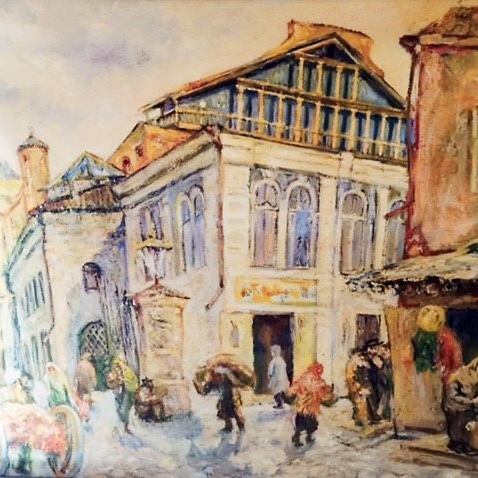
News

The art of remembering
NIA MAGOULIANITI-MCGREGOR
The exhibition, called “From Prisoner in Siberia to Artist in Safed, Israel. The story of Jewish destruction, survival and renewal as seen through the images of artist, David Labkovski (1906-1991)” has travelled the world. In South Africa, it went to Durban and will be exhibiting in Johannesburg on September 3.
Now living in Los Angeles, Raikin is in South Africa to talk about Labkovski’s art, as well as the David Labkovski Project, an educational programme she helped develop, that teaches students about Eastern European life before, during and after the Holocaust, through his art.
Raikin’s grandfather, Arthur Spektor, was Labkovski’s wife Rivka’s brother. He moved to South Africa from Lithuania in the 1920s. Arthur and Rivka were the only two Spektors who survived the Holocaust, the rest were killed by the Nazis and their Lithuanian collaborators in the forests of Ponar.
Rivka and David were never able to have children of their own and so Raikin’s mother, Barbara Barishman and her siblings Patricia Flaum and Robert Spektor, were like their own children.
Raikin says she has a personal connection to Labkovski and his work. “I grew up looking at his art hanging on my grandparents’ walls in South Africa, it’s in my DNA,” she says.
And as an artist and educator herself – as she travels throughout the US speaking on the Jews of South Africa, African tribal arts and the “Impact of Art as a Witness to History” – she recognises their artistic and historic significance.
“Labkovski’s art depicts pre-war Jewish life in Vilna in Lithuania, his time in a Siberian prison and stories recounted by Holocaust survivors living in Lithuania after the Second World War,” says Raikin. His work also shows the time of Labkovski’s “renewal” when he arrived in Israel in 1958.
“His art is a visual diary – it’s almost like finding an intimate journal,” she says. “It’s also a missing piece of history. That’s because, unlike Germany, Russia (where he spent many years) was on the same side as the Americans and there was no ‘liberation’ as such – no video footage or photos of the gulags.”
Labkovski lived in Vilna before the war, from 1908 to 1932. “Vilna was known as the Jerusalem of Lithuania. In the 1920s, he was part of a group of learners, thinkers, writers and other artists called the “Jung Vilna”, says Raikin.
Painting portraits and scenes of everyday life, he held his first art exhibition in 1922. In 1932, he was accepted into the prestigious Art Academy of Leningrad.
“He had these intense blue eyes,” says Raikin. “He’d look at you for a few seconds and then be able to draw you in perfect detail. Not only your physical characteristics, but your emotions, what you were thinking, what you were feeling… You couldn’t hide your emotions from him.”
But Labkovski was hauled out of art school and forced to enlist in the army before being sent to Siberia on trumped-up charges. His job became cutting logs in extreme temperatures.
“He was not the most physically robust man,” says Raikin. “He survived his eight years there only because, after word got around he was a painter, he became the prison’s sketch and tattoo artist. He received a few extra pieces of bread and it also meant he could now work inside.”
His artwork over that period are in muted colours. His self-portraits show an old man, though he is young, with hollow eyes. Prominent are steel buckets that would hold whatever food prisoners received. There is a painting of Labkovski sleeping with one of those buckets.
When he and his wife Rivka (who had also been in Siberia) returned to Lithuania after the war, they found the town and their community obliterated. They discovered that in 1941, some 70 000 people, mainly Jews, had been shot dead by Nazis.
“Labkovski painted the stories of the few survivors and he also drew on memory to paint how it used to be – the vibrant market place, the peddlers, the rabbis, the mothers – just average people going about their business.”
But the artworks showed evidence of impending doom, says Raikin. “A man struggling to push a cart, someone carrying a heavy load…”
As Raikin says: “You can see his soul is in his paintings. You feel the loss, the longing, the desperation, the grief…”
The couple – they’d had no children – moved to an artist colony in Safed, Israel, in 1958. He displayed his work there and while it was critically acclaimed artistically, it was unpopular with an audience who were in the process of trying to put recent horrors behind them. “They were trying to build a new life,” says Raikin.
“But David and Rivka were devastated at this reaction,” she says. “They decided they wouldn’t sell his art until a new generation would be open to the enormity of the destruction and the loss.”
Today, under the auspices of The David Labkovski Project, his work is being used to teach young people about life lessons, survival and the Holocaust, using a multidisciplinary programme of creative writing, art, history and social studies. “It allows young people to curate his work into an exhibition.
“It’s a slower introduction to the Holocaust,” she says.
Raikin is planning a training session for teachers in South Africa next year. “In order to fully grasp all that was lost in the Holocaust,” Raikin says, “it’s important not to teach about it in isolation. You have to understand this vibrant Jewish community, with its artists and writers who were celebrated and admired. Only when you understand what was, can you understand what was lost.”
• A portion of the originals of the exhibition will be exhibited at the Johannesburg Holocaust and Genocide Centre on September 3 at 18:00.




